An Investigation into maintaining safe practices amongst lab technicians during phlebotomy
VerifiedAdded on 2023/01/03
|16
|4419
|36
AI Summary
This dissertation investigates the importance of maintaining safe practices among lab technicians during phlebotomy. It explores the potential risks, effectiveness of safe practices, and ways to integrate and maintain safe sharp practices. The study aims to reduce errors and improve health outcomes.
Contribute Materials
Your contribution can guide someone’s learning journey. Share your
documents today.

Dissertation
1
1
Secure Best Marks with AI Grader
Need help grading? Try our AI Grader for instant feedback on your assignments.
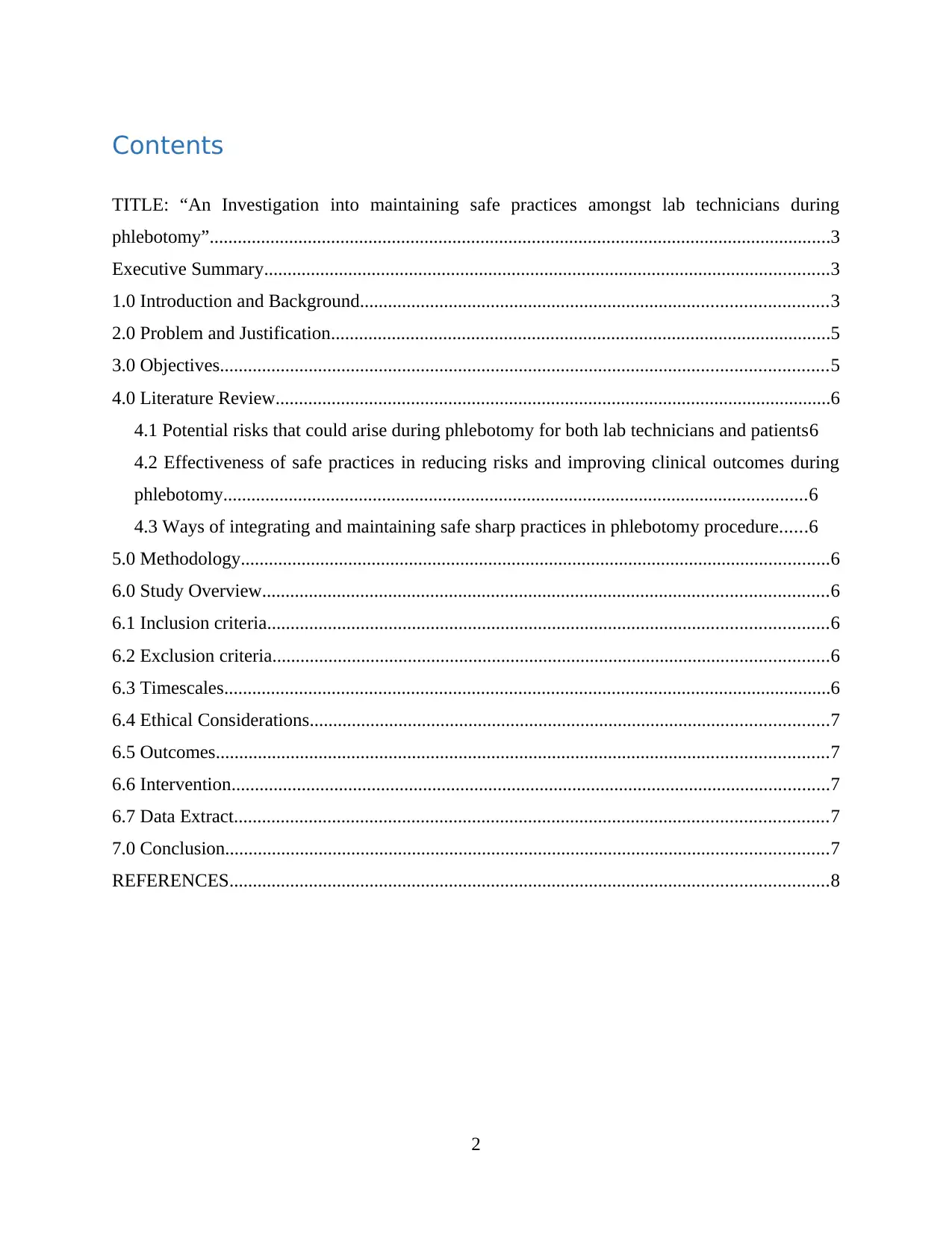
Contents
TITLE: “An Investigation into maintaining safe practices amongst lab technicians during
phlebotomy”.....................................................................................................................................3
Executive Summary.........................................................................................................................3
1.0 Introduction and Background....................................................................................................3
2.0 Problem and Justification...........................................................................................................5
3.0 Objectives..................................................................................................................................5
4.0 Literature Review.......................................................................................................................6
4.1 Potential risks that could arise during phlebotomy for both lab technicians and patients6
4.2 Effectiveness of safe practices in reducing risks and improving clinical outcomes during
phlebotomy.............................................................................................................................6
4.3 Ways of integrating and maintaining safe sharp practices in phlebotomy procedure......6
5.0 Methodology..............................................................................................................................6
6.0 Study Overview.........................................................................................................................6
6.1 Inclusion criteria........................................................................................................................6
6.2 Exclusion criteria.......................................................................................................................6
6.3 Timescales..................................................................................................................................6
6.4 Ethical Considerations...............................................................................................................7
6.5 Outcomes...................................................................................................................................7
6.6 Intervention................................................................................................................................7
6.7 Data Extract...............................................................................................................................7
7.0 Conclusion.................................................................................................................................7
REFERENCES................................................................................................................................8
2
TITLE: “An Investigation into maintaining safe practices amongst lab technicians during
phlebotomy”.....................................................................................................................................3
Executive Summary.........................................................................................................................3
1.0 Introduction and Background....................................................................................................3
2.0 Problem and Justification...........................................................................................................5
3.0 Objectives..................................................................................................................................5
4.0 Literature Review.......................................................................................................................6
4.1 Potential risks that could arise during phlebotomy for both lab technicians and patients6
4.2 Effectiveness of safe practices in reducing risks and improving clinical outcomes during
phlebotomy.............................................................................................................................6
4.3 Ways of integrating and maintaining safe sharp practices in phlebotomy procedure......6
5.0 Methodology..............................................................................................................................6
6.0 Study Overview.........................................................................................................................6
6.1 Inclusion criteria........................................................................................................................6
6.2 Exclusion criteria.......................................................................................................................6
6.3 Timescales..................................................................................................................................6
6.4 Ethical Considerations...............................................................................................................7
6.5 Outcomes...................................................................................................................................7
6.6 Intervention................................................................................................................................7
6.7 Data Extract...............................................................................................................................7
7.0 Conclusion.................................................................................................................................7
REFERENCES................................................................................................................................8
2
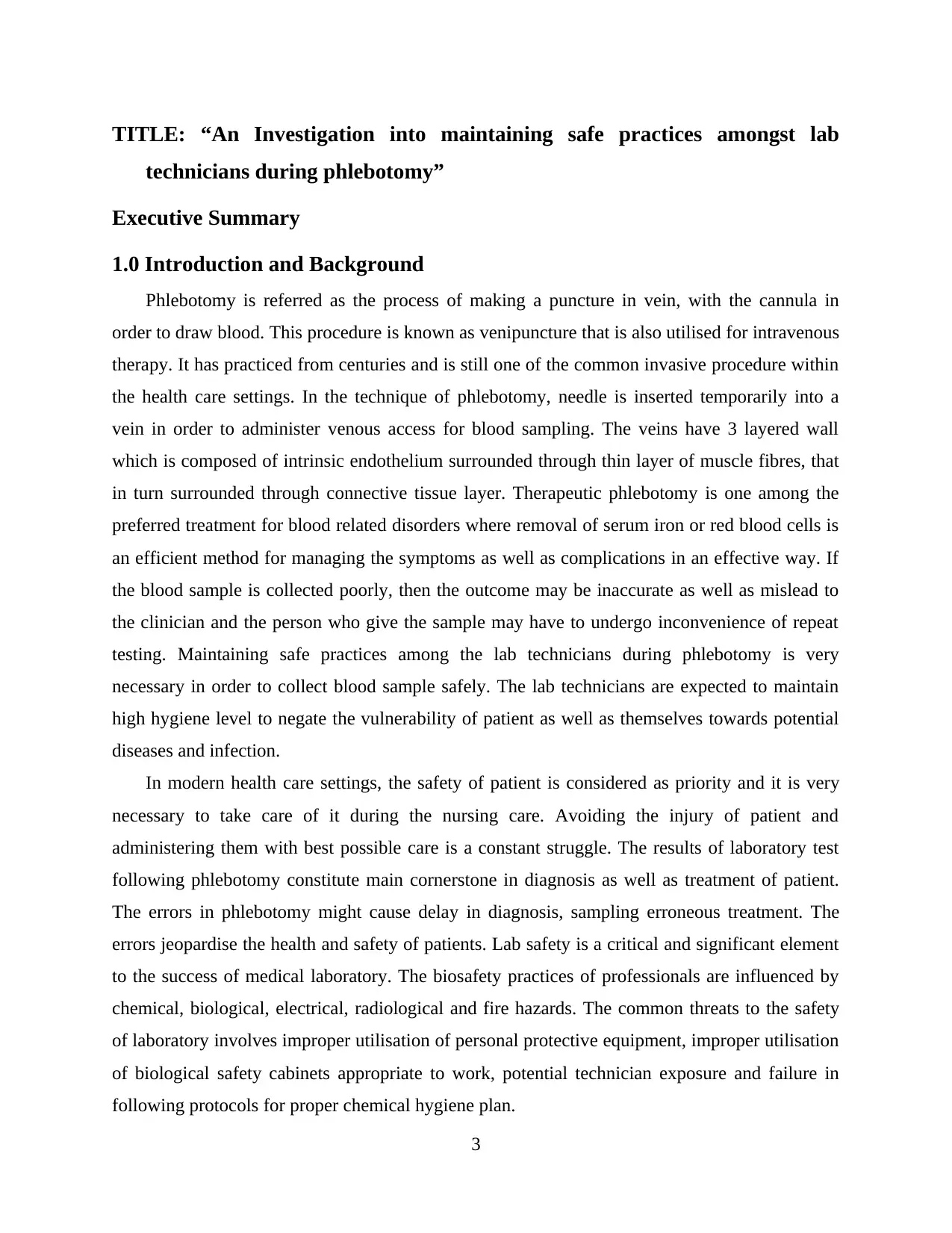
TITLE: “An Investigation into maintaining safe practices amongst lab
technicians during phlebotomy”
Executive Summary
1.0 Introduction and Background
Phlebotomy is referred as the process of making a puncture in vein, with the cannula in
order to draw blood. This procedure is known as venipuncture that is also utilised for intravenous
therapy. It has practiced from centuries and is still one of the common invasive procedure within
the health care settings. In the technique of phlebotomy, needle is inserted temporarily into a
vein in order to administer venous access for blood sampling. The veins have 3 layered wall
which is composed of intrinsic endothelium surrounded through thin layer of muscle fibres, that
in turn surrounded through connective tissue layer. Therapeutic phlebotomy is one among the
preferred treatment for blood related disorders where removal of serum iron or red blood cells is
an efficient method for managing the symptoms as well as complications in an effective way. If
the blood sample is collected poorly, then the outcome may be inaccurate as well as mislead to
the clinician and the person who give the sample may have to undergo inconvenience of repeat
testing. Maintaining safe practices among the lab technicians during phlebotomy is very
necessary in order to collect blood sample safely. The lab technicians are expected to maintain
high hygiene level to negate the vulnerability of patient as well as themselves towards potential
diseases and infection.
In modern health care settings, the safety of patient is considered as priority and it is very
necessary to take care of it during the nursing care. Avoiding the injury of patient and
administering them with best possible care is a constant struggle. The results of laboratory test
following phlebotomy constitute main cornerstone in diagnosis as well as treatment of patient.
The errors in phlebotomy might cause delay in diagnosis, sampling erroneous treatment. The
errors jeopardise the health and safety of patients. Lab safety is a critical and significant element
to the success of medical laboratory. The biosafety practices of professionals are influenced by
chemical, biological, electrical, radiological and fire hazards. The common threats to the safety
of laboratory involves improper utilisation of personal protective equipment, improper utilisation
of biological safety cabinets appropriate to work, potential technician exposure and failure in
following protocols for proper chemical hygiene plan.
3
technicians during phlebotomy”
Executive Summary
1.0 Introduction and Background
Phlebotomy is referred as the process of making a puncture in vein, with the cannula in
order to draw blood. This procedure is known as venipuncture that is also utilised for intravenous
therapy. It has practiced from centuries and is still one of the common invasive procedure within
the health care settings. In the technique of phlebotomy, needle is inserted temporarily into a
vein in order to administer venous access for blood sampling. The veins have 3 layered wall
which is composed of intrinsic endothelium surrounded through thin layer of muscle fibres, that
in turn surrounded through connective tissue layer. Therapeutic phlebotomy is one among the
preferred treatment for blood related disorders where removal of serum iron or red blood cells is
an efficient method for managing the symptoms as well as complications in an effective way. If
the blood sample is collected poorly, then the outcome may be inaccurate as well as mislead to
the clinician and the person who give the sample may have to undergo inconvenience of repeat
testing. Maintaining safe practices among the lab technicians during phlebotomy is very
necessary in order to collect blood sample safely. The lab technicians are expected to maintain
high hygiene level to negate the vulnerability of patient as well as themselves towards potential
diseases and infection.
In modern health care settings, the safety of patient is considered as priority and it is very
necessary to take care of it during the nursing care. Avoiding the injury of patient and
administering them with best possible care is a constant struggle. The results of laboratory test
following phlebotomy constitute main cornerstone in diagnosis as well as treatment of patient.
The errors in phlebotomy might cause delay in diagnosis, sampling erroneous treatment. The
errors jeopardise the health and safety of patients. Lab safety is a critical and significant element
to the success of medical laboratory. The biosafety practices of professionals are influenced by
chemical, biological, electrical, radiological and fire hazards. The common threats to the safety
of laboratory involves improper utilisation of personal protective equipment, improper utilisation
of biological safety cabinets appropriate to work, potential technician exposure and failure in
following protocols for proper chemical hygiene plan.
3
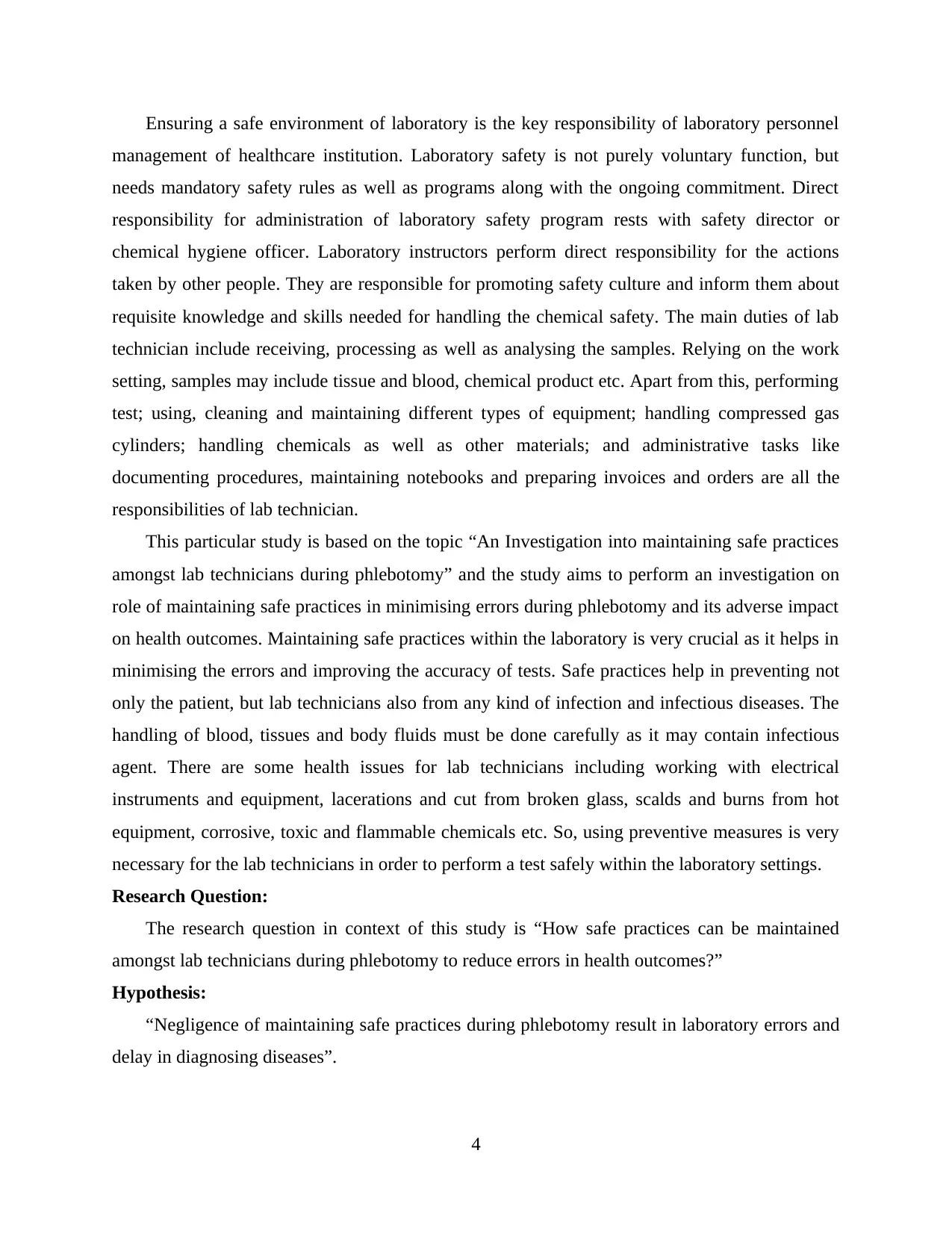
Ensuring a safe environment of laboratory is the key responsibility of laboratory personnel
management of healthcare institution. Laboratory safety is not purely voluntary function, but
needs mandatory safety rules as well as programs along with the ongoing commitment. Direct
responsibility for administration of laboratory safety program rests with safety director or
chemical hygiene officer. Laboratory instructors perform direct responsibility for the actions
taken by other people. They are responsible for promoting safety culture and inform them about
requisite knowledge and skills needed for handling the chemical safety. The main duties of lab
technician include receiving, processing as well as analysing the samples. Relying on the work
setting, samples may include tissue and blood, chemical product etc. Apart from this, performing
test; using, cleaning and maintaining different types of equipment; handling compressed gas
cylinders; handling chemicals as well as other materials; and administrative tasks like
documenting procedures, maintaining notebooks and preparing invoices and orders are all the
responsibilities of lab technician.
This particular study is based on the topic “An Investigation into maintaining safe practices
amongst lab technicians during phlebotomy” and the study aims to perform an investigation on
role of maintaining safe practices in minimising errors during phlebotomy and its adverse impact
on health outcomes. Maintaining safe practices within the laboratory is very crucial as it helps in
minimising the errors and improving the accuracy of tests. Safe practices help in preventing not
only the patient, but lab technicians also from any kind of infection and infectious diseases. The
handling of blood, tissues and body fluids must be done carefully as it may contain infectious
agent. There are some health issues for lab technicians including working with electrical
instruments and equipment, lacerations and cut from broken glass, scalds and burns from hot
equipment, corrosive, toxic and flammable chemicals etc. So, using preventive measures is very
necessary for the lab technicians in order to perform a test safely within the laboratory settings.
Research Question:
The research question in context of this study is “How safe practices can be maintained
amongst lab technicians during phlebotomy to reduce errors in health outcomes?”
Hypothesis:
“Negligence of maintaining safe practices during phlebotomy result in laboratory errors and
delay in diagnosing diseases”.
4
management of healthcare institution. Laboratory safety is not purely voluntary function, but
needs mandatory safety rules as well as programs along with the ongoing commitment. Direct
responsibility for administration of laboratory safety program rests with safety director or
chemical hygiene officer. Laboratory instructors perform direct responsibility for the actions
taken by other people. They are responsible for promoting safety culture and inform them about
requisite knowledge and skills needed for handling the chemical safety. The main duties of lab
technician include receiving, processing as well as analysing the samples. Relying on the work
setting, samples may include tissue and blood, chemical product etc. Apart from this, performing
test; using, cleaning and maintaining different types of equipment; handling compressed gas
cylinders; handling chemicals as well as other materials; and administrative tasks like
documenting procedures, maintaining notebooks and preparing invoices and orders are all the
responsibilities of lab technician.
This particular study is based on the topic “An Investigation into maintaining safe practices
amongst lab technicians during phlebotomy” and the study aims to perform an investigation on
role of maintaining safe practices in minimising errors during phlebotomy and its adverse impact
on health outcomes. Maintaining safe practices within the laboratory is very crucial as it helps in
minimising the errors and improving the accuracy of tests. Safe practices help in preventing not
only the patient, but lab technicians also from any kind of infection and infectious diseases. The
handling of blood, tissues and body fluids must be done carefully as it may contain infectious
agent. There are some health issues for lab technicians including working with electrical
instruments and equipment, lacerations and cut from broken glass, scalds and burns from hot
equipment, corrosive, toxic and flammable chemicals etc. So, using preventive measures is very
necessary for the lab technicians in order to perform a test safely within the laboratory settings.
Research Question:
The research question in context of this study is “How safe practices can be maintained
amongst lab technicians during phlebotomy to reduce errors in health outcomes?”
Hypothesis:
“Negligence of maintaining safe practices during phlebotomy result in laboratory errors and
delay in diagnosing diseases”.
4
Secure Best Marks with AI Grader
Need help grading? Try our AI Grader for instant feedback on your assignments.
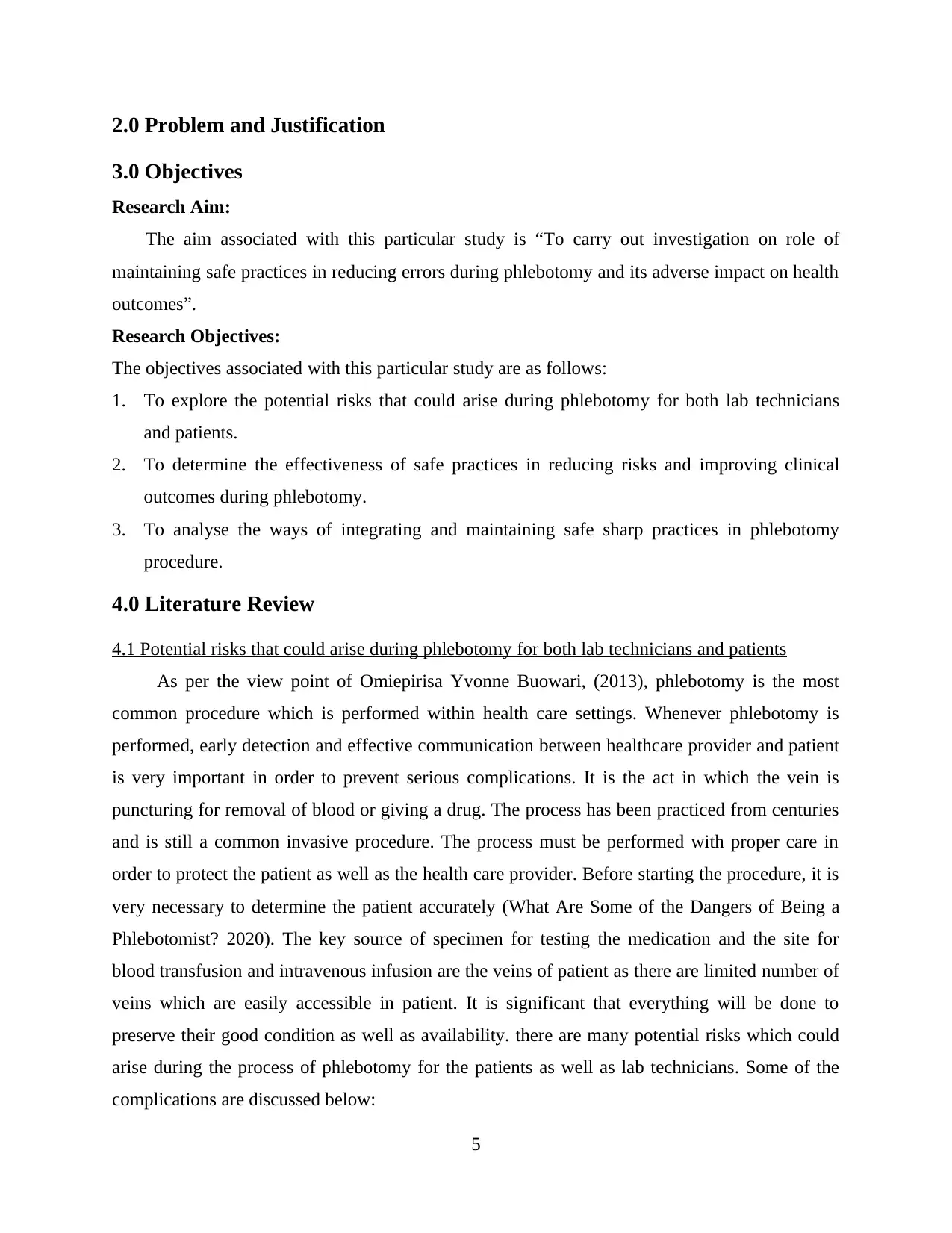
2.0 Problem and Justification
3.0 Objectives
Research Aim:
The aim associated with this particular study is “To carry out investigation on role of
maintaining safe practices in reducing errors during phlebotomy and its adverse impact on health
outcomes”.
Research Objectives:
The objectives associated with this particular study are as follows:
1. To explore the potential risks that could arise during phlebotomy for both lab technicians
and patients.
2. To determine the effectiveness of safe practices in reducing risks and improving clinical
outcomes during phlebotomy.
3. To analyse the ways of integrating and maintaining safe sharp practices in phlebotomy
procedure.
4.0 Literature Review
4.1 Potential risks that could arise during phlebotomy for both lab technicians and patients
As per the view point of Omiepirisa Yvonne Buowari, (2013), phlebotomy is the most
common procedure which is performed within health care settings. Whenever phlebotomy is
performed, early detection and effective communication between healthcare provider and patient
is very important in order to prevent serious complications. It is the act in which the vein is
puncturing for removal of blood or giving a drug. The process has been practiced from centuries
and is still a common invasive procedure. The process must be performed with proper care in
order to protect the patient as well as the health care provider. Before starting the procedure, it is
very necessary to determine the patient accurately (What Are Some of the Dangers of Being a
Phlebotomist? 2020). The key source of specimen for testing the medication and the site for
blood transfusion and intravenous infusion are the veins of patient as there are limited number of
veins which are easily accessible in patient. It is significant that everything will be done to
preserve their good condition as well as availability. there are many potential risks which could
arise during the process of phlebotomy for the patients as well as lab technicians. Some of the
complications are discussed below:
5
3.0 Objectives
Research Aim:
The aim associated with this particular study is “To carry out investigation on role of
maintaining safe practices in reducing errors during phlebotomy and its adverse impact on health
outcomes”.
Research Objectives:
The objectives associated with this particular study are as follows:
1. To explore the potential risks that could arise during phlebotomy for both lab technicians
and patients.
2. To determine the effectiveness of safe practices in reducing risks and improving clinical
outcomes during phlebotomy.
3. To analyse the ways of integrating and maintaining safe sharp practices in phlebotomy
procedure.
4.0 Literature Review
4.1 Potential risks that could arise during phlebotomy for both lab technicians and patients
As per the view point of Omiepirisa Yvonne Buowari, (2013), phlebotomy is the most
common procedure which is performed within health care settings. Whenever phlebotomy is
performed, early detection and effective communication between healthcare provider and patient
is very important in order to prevent serious complications. It is the act in which the vein is
puncturing for removal of blood or giving a drug. The process has been practiced from centuries
and is still a common invasive procedure. The process must be performed with proper care in
order to protect the patient as well as the health care provider. Before starting the procedure, it is
very necessary to determine the patient accurately (What Are Some of the Dangers of Being a
Phlebotomist? 2020). The key source of specimen for testing the medication and the site for
blood transfusion and intravenous infusion are the veins of patient as there are limited number of
veins which are easily accessible in patient. It is significant that everything will be done to
preserve their good condition as well as availability. there are many potential risks which could
arise during the process of phlebotomy for the patients as well as lab technicians. Some of the
complications are discussed below:
5
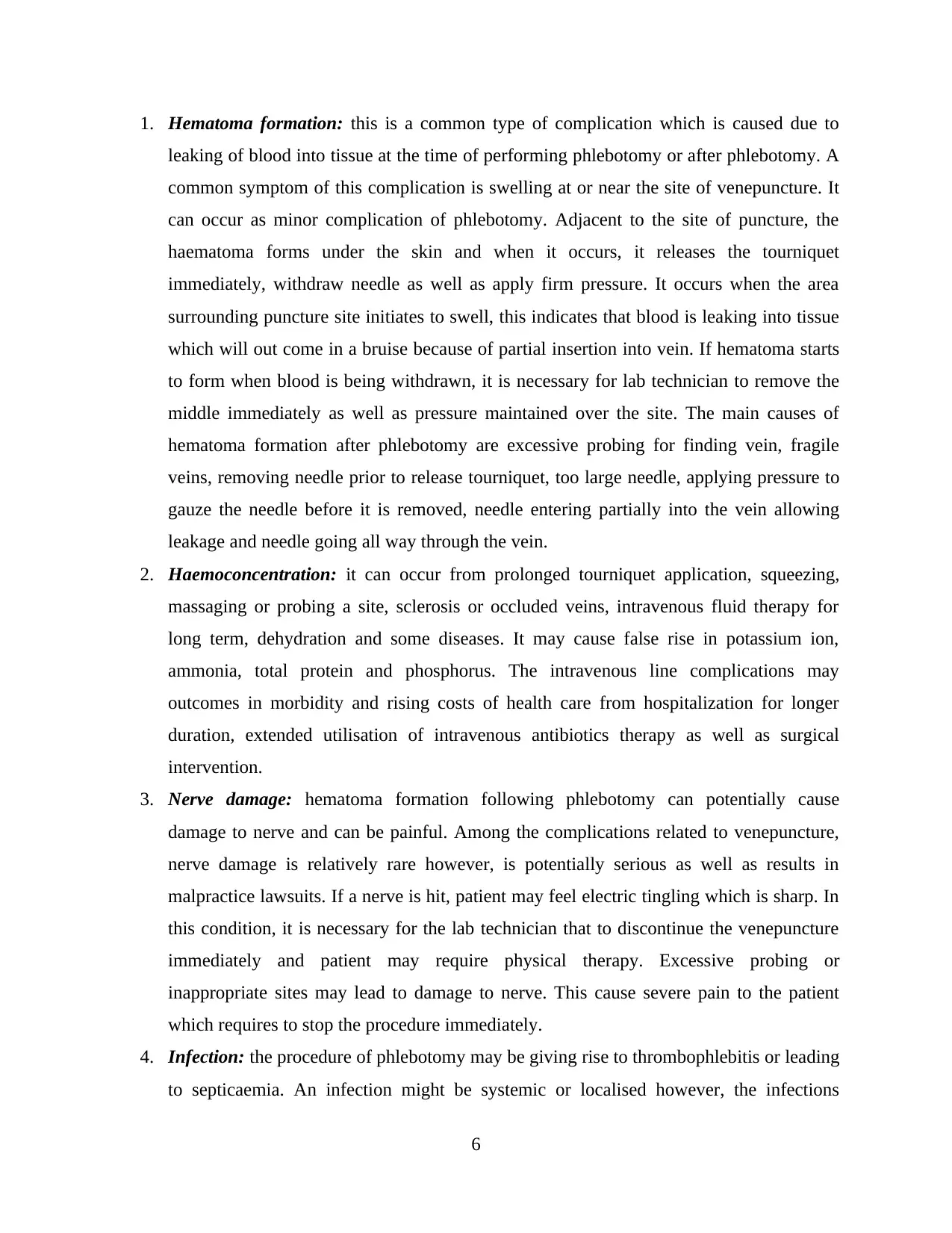
1. Hematoma formation: this is a common type of complication which is caused due to
leaking of blood into tissue at the time of performing phlebotomy or after phlebotomy. A
common symptom of this complication is swelling at or near the site of venepuncture. It
can occur as minor complication of phlebotomy. Adjacent to the site of puncture, the
haematoma forms under the skin and when it occurs, it releases the tourniquet
immediately, withdraw needle as well as apply firm pressure. It occurs when the area
surrounding puncture site initiates to swell, this indicates that blood is leaking into tissue
which will out come in a bruise because of partial insertion into vein. If hematoma starts
to form when blood is being withdrawn, it is necessary for lab technician to remove the
middle immediately as well as pressure maintained over the site. The main causes of
hematoma formation after phlebotomy are excessive probing for finding vein, fragile
veins, removing needle prior to release tourniquet, too large needle, applying pressure to
gauze the needle before it is removed, needle entering partially into the vein allowing
leakage and needle going all way through the vein.
2. Haemoconcentration: it can occur from prolonged tourniquet application, squeezing,
massaging or probing a site, sclerosis or occluded veins, intravenous fluid therapy for
long term, dehydration and some diseases. It may cause false rise in potassium ion,
ammonia, total protein and phosphorus. The intravenous line complications may
outcomes in morbidity and rising costs of health care from hospitalization for longer
duration, extended utilisation of intravenous antibiotics therapy as well as surgical
intervention.
3. Nerve damage: hematoma formation following phlebotomy can potentially cause
damage to nerve and can be painful. Among the complications related to venepuncture,
nerve damage is relatively rare however, is potentially serious as well as results in
malpractice lawsuits. If a nerve is hit, patient may feel electric tingling which is sharp. In
this condition, it is necessary for the lab technician that to discontinue the venepuncture
immediately and patient may require physical therapy. Excessive probing or
inappropriate sites may lead to damage to nerve. This cause severe pain to the patient
which requires to stop the procedure immediately.
4. Infection: the procedure of phlebotomy may be giving rise to thrombophlebitis or leading
to septicaemia. An infection might be systemic or localised however, the infections
6
leaking of blood into tissue at the time of performing phlebotomy or after phlebotomy. A
common symptom of this complication is swelling at or near the site of venepuncture. It
can occur as minor complication of phlebotomy. Adjacent to the site of puncture, the
haematoma forms under the skin and when it occurs, it releases the tourniquet
immediately, withdraw needle as well as apply firm pressure. It occurs when the area
surrounding puncture site initiates to swell, this indicates that blood is leaking into tissue
which will out come in a bruise because of partial insertion into vein. If hematoma starts
to form when blood is being withdrawn, it is necessary for lab technician to remove the
middle immediately as well as pressure maintained over the site. The main causes of
hematoma formation after phlebotomy are excessive probing for finding vein, fragile
veins, removing needle prior to release tourniquet, too large needle, applying pressure to
gauze the needle before it is removed, needle entering partially into the vein allowing
leakage and needle going all way through the vein.
2. Haemoconcentration: it can occur from prolonged tourniquet application, squeezing,
massaging or probing a site, sclerosis or occluded veins, intravenous fluid therapy for
long term, dehydration and some diseases. It may cause false rise in potassium ion,
ammonia, total protein and phosphorus. The intravenous line complications may
outcomes in morbidity and rising costs of health care from hospitalization for longer
duration, extended utilisation of intravenous antibiotics therapy as well as surgical
intervention.
3. Nerve damage: hematoma formation following phlebotomy can potentially cause
damage to nerve and can be painful. Among the complications related to venepuncture,
nerve damage is relatively rare however, is potentially serious as well as results in
malpractice lawsuits. If a nerve is hit, patient may feel electric tingling which is sharp. In
this condition, it is necessary for the lab technician that to discontinue the venepuncture
immediately and patient may require physical therapy. Excessive probing or
inappropriate sites may lead to damage to nerve. This cause severe pain to the patient
which requires to stop the procedure immediately.
4. Infection: the procedure of phlebotomy may be giving rise to thrombophlebitis or leading
to septicaemia. An infection might be systemic or localised however, the infections
6
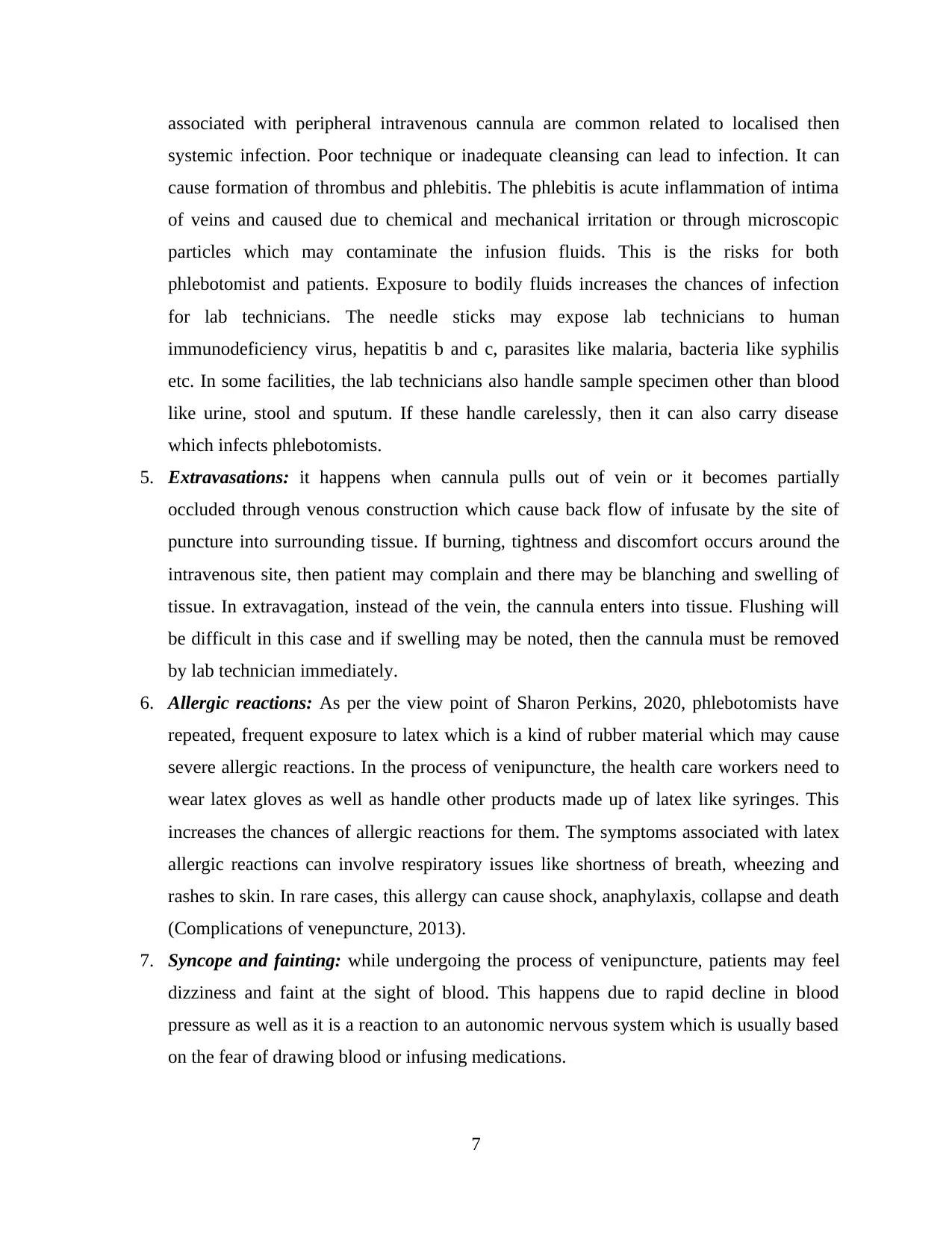
associated with peripheral intravenous cannula are common related to localised then
systemic infection. Poor technique or inadequate cleansing can lead to infection. It can
cause formation of thrombus and phlebitis. The phlebitis is acute inflammation of intima
of veins and caused due to chemical and mechanical irritation or through microscopic
particles which may contaminate the infusion fluids. This is the risks for both
phlebotomist and patients. Exposure to bodily fluids increases the chances of infection
for lab technicians. The needle sticks may expose lab technicians to human
immunodeficiency virus, hepatitis b and c, parasites like malaria, bacteria like syphilis
etc. In some facilities, the lab technicians also handle sample specimen other than blood
like urine, stool and sputum. If these handle carelessly, then it can also carry disease
which infects phlebotomists.
5. Extravasations: it happens when cannula pulls out of vein or it becomes partially
occluded through venous construction which cause back flow of infusate by the site of
puncture into surrounding tissue. If burning, tightness and discomfort occurs around the
intravenous site, then patient may complain and there may be blanching and swelling of
tissue. In extravagation, instead of the vein, the cannula enters into tissue. Flushing will
be difficult in this case and if swelling may be noted, then the cannula must be removed
by lab technician immediately.
6. Allergic reactions: As per the view point of Sharon Perkins, 2020, phlebotomists have
repeated, frequent exposure to latex which is a kind of rubber material which may cause
severe allergic reactions. In the process of venipuncture, the health care workers need to
wear latex gloves as well as handle other products made up of latex like syringes. This
increases the chances of allergic reactions for them. The symptoms associated with latex
allergic reactions can involve respiratory issues like shortness of breath, wheezing and
rashes to skin. In rare cases, this allergy can cause shock, anaphylaxis, collapse and death
(Complications of venepuncture, 2013).
7. Syncope and fainting: while undergoing the process of venipuncture, patients may feel
dizziness and faint at the sight of blood. This happens due to rapid decline in blood
pressure as well as it is a reaction to an autonomic nervous system which is usually based
on the fear of drawing blood or infusing medications.
7
systemic infection. Poor technique or inadequate cleansing can lead to infection. It can
cause formation of thrombus and phlebitis. The phlebitis is acute inflammation of intima
of veins and caused due to chemical and mechanical irritation or through microscopic
particles which may contaminate the infusion fluids. This is the risks for both
phlebotomist and patients. Exposure to bodily fluids increases the chances of infection
for lab technicians. The needle sticks may expose lab technicians to human
immunodeficiency virus, hepatitis b and c, parasites like malaria, bacteria like syphilis
etc. In some facilities, the lab technicians also handle sample specimen other than blood
like urine, stool and sputum. If these handle carelessly, then it can also carry disease
which infects phlebotomists.
5. Extravasations: it happens when cannula pulls out of vein or it becomes partially
occluded through venous construction which cause back flow of infusate by the site of
puncture into surrounding tissue. If burning, tightness and discomfort occurs around the
intravenous site, then patient may complain and there may be blanching and swelling of
tissue. In extravagation, instead of the vein, the cannula enters into tissue. Flushing will
be difficult in this case and if swelling may be noted, then the cannula must be removed
by lab technician immediately.
6. Allergic reactions: As per the view point of Sharon Perkins, 2020, phlebotomists have
repeated, frequent exposure to latex which is a kind of rubber material which may cause
severe allergic reactions. In the process of venipuncture, the health care workers need to
wear latex gloves as well as handle other products made up of latex like syringes. This
increases the chances of allergic reactions for them. The symptoms associated with latex
allergic reactions can involve respiratory issues like shortness of breath, wheezing and
rashes to skin. In rare cases, this allergy can cause shock, anaphylaxis, collapse and death
(Complications of venepuncture, 2013).
7. Syncope and fainting: while undergoing the process of venipuncture, patients may feel
dizziness and faint at the sight of blood. This happens due to rapid decline in blood
pressure as well as it is a reaction to an autonomic nervous system which is usually based
on the fear of drawing blood or infusing medications.
7
Paraphrase This Document
Need a fresh take? Get an instant paraphrase of this document with our AI Paraphraser
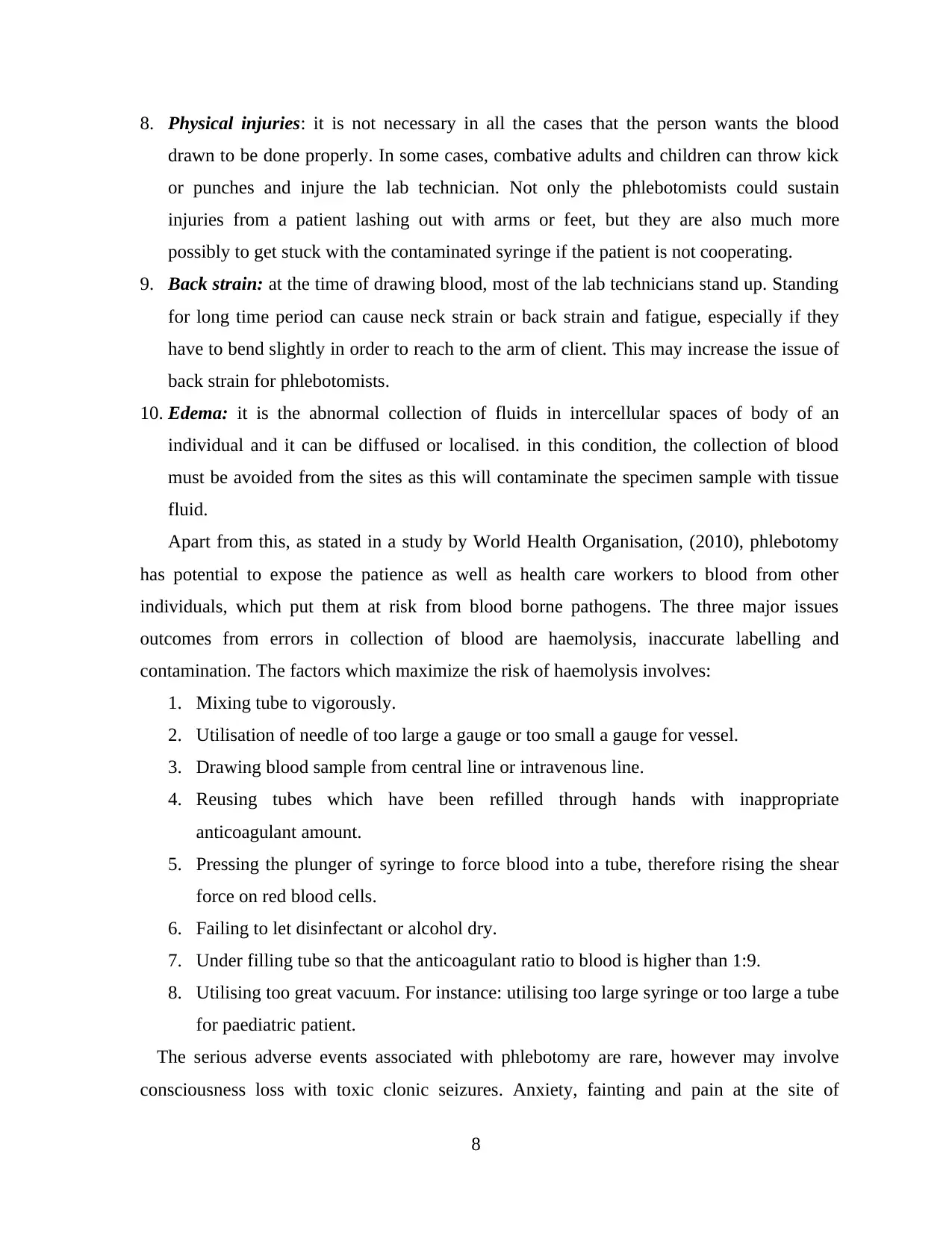
8. Physical injuries: it is not necessary in all the cases that the person wants the blood
drawn to be done properly. In some cases, combative adults and children can throw kick
or punches and injure the lab technician. Not only the phlebotomists could sustain
injuries from a patient lashing out with arms or feet, but they are also much more
possibly to get stuck with the contaminated syringe if the patient is not cooperating.
9. Back strain: at the time of drawing blood, most of the lab technicians stand up. Standing
for long time period can cause neck strain or back strain and fatigue, especially if they
have to bend slightly in order to reach to the arm of client. This may increase the issue of
back strain for phlebotomists.
10. Edema: it is the abnormal collection of fluids in intercellular spaces of body of an
individual and it can be diffused or localised. in this condition, the collection of blood
must be avoided from the sites as this will contaminate the specimen sample with tissue
fluid.
Apart from this, as stated in a study by World Health Organisation, (2010), phlebotomy
has potential to expose the patience as well as health care workers to blood from other
individuals, which put them at risk from blood borne pathogens. The three major issues
outcomes from errors in collection of blood are haemolysis, inaccurate labelling and
contamination. The factors which maximize the risk of haemolysis involves:
1. Mixing tube to vigorously.
2. Utilisation of needle of too large a gauge or too small a gauge for vessel.
3. Drawing blood sample from central line or intravenous line.
4. Reusing tubes which have been refilled through hands with inappropriate
anticoagulant amount.
5. Pressing the plunger of syringe to force blood into a tube, therefore rising the shear
force on red blood cells.
6. Failing to let disinfectant or alcohol dry.
7. Under filling tube so that the anticoagulant ratio to blood is higher than 1:9.
8. Utilising too great vacuum. For instance: utilising too large syringe or too large a tube
for paediatric patient.
The serious adverse events associated with phlebotomy are rare, however may involve
consciousness loss with toxic clonic seizures. Anxiety, fainting and pain at the site of
8
drawn to be done properly. In some cases, combative adults and children can throw kick
or punches and injure the lab technician. Not only the phlebotomists could sustain
injuries from a patient lashing out with arms or feet, but they are also much more
possibly to get stuck with the contaminated syringe if the patient is not cooperating.
9. Back strain: at the time of drawing blood, most of the lab technicians stand up. Standing
for long time period can cause neck strain or back strain and fatigue, especially if they
have to bend slightly in order to reach to the arm of client. This may increase the issue of
back strain for phlebotomists.
10. Edema: it is the abnormal collection of fluids in intercellular spaces of body of an
individual and it can be diffused or localised. in this condition, the collection of blood
must be avoided from the sites as this will contaminate the specimen sample with tissue
fluid.
Apart from this, as stated in a study by World Health Organisation, (2010), phlebotomy
has potential to expose the patience as well as health care workers to blood from other
individuals, which put them at risk from blood borne pathogens. The three major issues
outcomes from errors in collection of blood are haemolysis, inaccurate labelling and
contamination. The factors which maximize the risk of haemolysis involves:
1. Mixing tube to vigorously.
2. Utilisation of needle of too large a gauge or too small a gauge for vessel.
3. Drawing blood sample from central line or intravenous line.
4. Reusing tubes which have been refilled through hands with inappropriate
anticoagulant amount.
5. Pressing the plunger of syringe to force blood into a tube, therefore rising the shear
force on red blood cells.
6. Failing to let disinfectant or alcohol dry.
7. Under filling tube so that the anticoagulant ratio to blood is higher than 1:9.
8. Utilising too great vacuum. For instance: utilising too large syringe or too large a tube
for paediatric patient.
The serious adverse events associated with phlebotomy are rare, however may involve
consciousness loss with toxic clonic seizures. Anxiety, fainting and pain at the site of
8
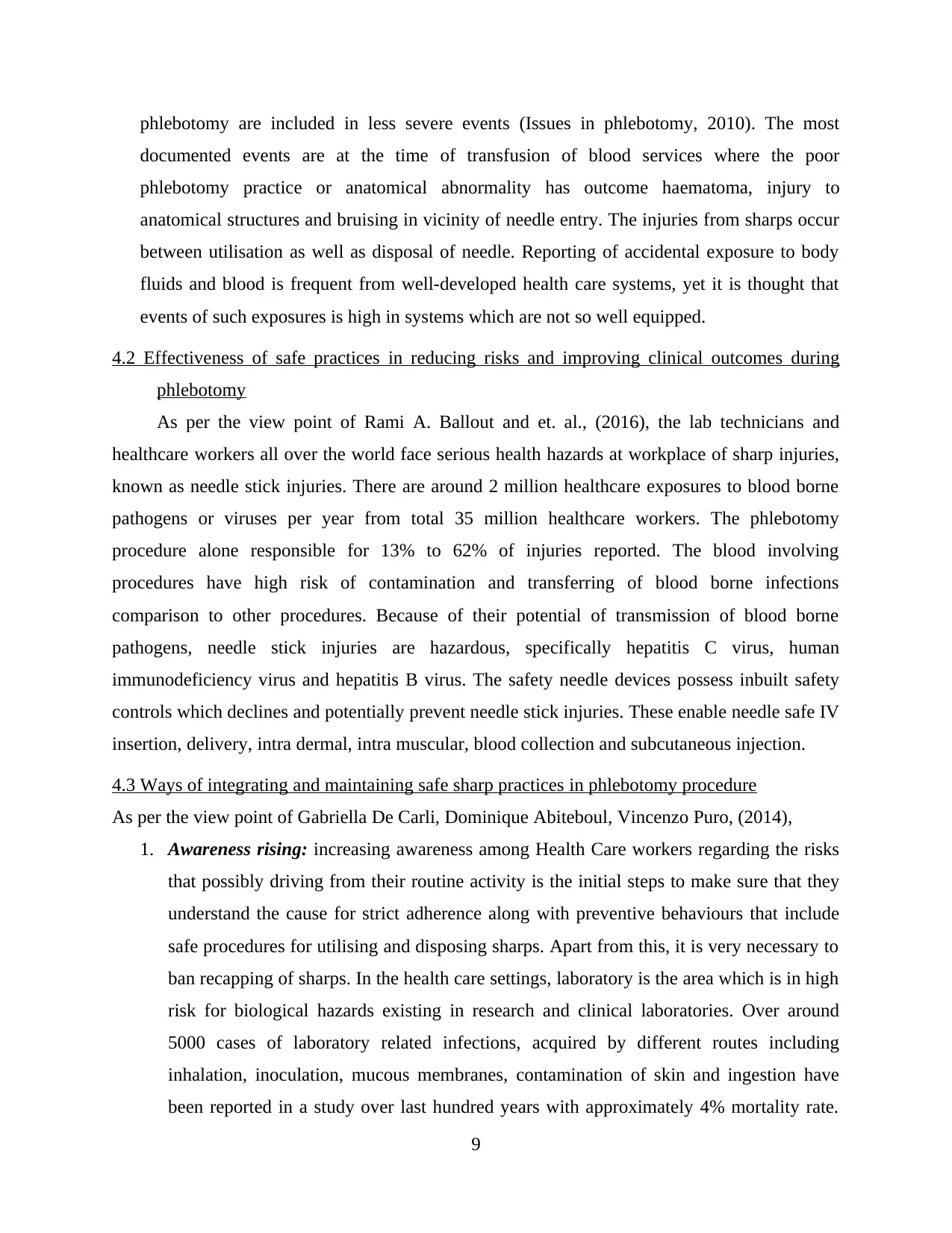
phlebotomy are included in less severe events (Issues in phlebotomy, 2010). The most
documented events are at the time of transfusion of blood services where the poor
phlebotomy practice or anatomical abnormality has outcome haematoma, injury to
anatomical structures and bruising in vicinity of needle entry. The injuries from sharps occur
between utilisation as well as disposal of needle. Reporting of accidental exposure to body
fluids and blood is frequent from well-developed health care systems, yet it is thought that
events of such exposures is high in systems which are not so well equipped.
4.2 Effectiveness of safe practices in reducing risks and improving clinical outcomes during
phlebotomy
As per the view point of Rami A. Ballout and et. al., (2016), the lab technicians and
healthcare workers all over the world face serious health hazards at workplace of sharp injuries,
known as needle stick injuries. There are around 2 million healthcare exposures to blood borne
pathogens or viruses per year from total 35 million healthcare workers. The phlebotomy
procedure alone responsible for 13% to 62% of injuries reported. The blood involving
procedures have high risk of contamination and transferring of blood borne infections
comparison to other procedures. Because of their potential of transmission of blood borne
pathogens, needle stick injuries are hazardous, specifically hepatitis C virus, human
immunodeficiency virus and hepatitis B virus. The safety needle devices possess inbuilt safety
controls which declines and potentially prevent needle stick injuries. These enable needle safe IV
insertion, delivery, intra dermal, intra muscular, blood collection and subcutaneous injection.
4.3 Ways of integrating and maintaining safe sharp practices in phlebotomy procedure
As per the view point of Gabriella De Carli, Dominique Abiteboul, Vincenzo Puro, (2014),
1. Awareness rising: increasing awareness among Health Care workers regarding the risks
that possibly driving from their routine activity is the initial steps to make sure that they
understand the cause for strict adherence along with preventive behaviours that include
safe procedures for utilising and disposing sharps. Apart from this, it is very necessary to
ban recapping of sharps. In the health care settings, laboratory is the area which is in high
risk for biological hazards existing in research and clinical laboratories. Over around
5000 cases of laboratory related infections, acquired by different routes including
inhalation, inoculation, mucous membranes, contamination of skin and ingestion have
been reported in a study over last hundred years with approximately 4% mortality rate.
9
documented events are at the time of transfusion of blood services where the poor
phlebotomy practice or anatomical abnormality has outcome haematoma, injury to
anatomical structures and bruising in vicinity of needle entry. The injuries from sharps occur
between utilisation as well as disposal of needle. Reporting of accidental exposure to body
fluids and blood is frequent from well-developed health care systems, yet it is thought that
events of such exposures is high in systems which are not so well equipped.
4.2 Effectiveness of safe practices in reducing risks and improving clinical outcomes during
phlebotomy
As per the view point of Rami A. Ballout and et. al., (2016), the lab technicians and
healthcare workers all over the world face serious health hazards at workplace of sharp injuries,
known as needle stick injuries. There are around 2 million healthcare exposures to blood borne
pathogens or viruses per year from total 35 million healthcare workers. The phlebotomy
procedure alone responsible for 13% to 62% of injuries reported. The blood involving
procedures have high risk of contamination and transferring of blood borne infections
comparison to other procedures. Because of their potential of transmission of blood borne
pathogens, needle stick injuries are hazardous, specifically hepatitis C virus, human
immunodeficiency virus and hepatitis B virus. The safety needle devices possess inbuilt safety
controls which declines and potentially prevent needle stick injuries. These enable needle safe IV
insertion, delivery, intra dermal, intra muscular, blood collection and subcutaneous injection.
4.3 Ways of integrating and maintaining safe sharp practices in phlebotomy procedure
As per the view point of Gabriella De Carli, Dominique Abiteboul, Vincenzo Puro, (2014),
1. Awareness rising: increasing awareness among Health Care workers regarding the risks
that possibly driving from their routine activity is the initial steps to make sure that they
understand the cause for strict adherence along with preventive behaviours that include
safe procedures for utilising and disposing sharps. Apart from this, it is very necessary to
ban recapping of sharps. In the health care settings, laboratory is the area which is in high
risk for biological hazards existing in research and clinical laboratories. Over around
5000 cases of laboratory related infections, acquired by different routes including
inhalation, inoculation, mucous membranes, contamination of skin and ingestion have
been reported in a study over last hundred years with approximately 4% mortality rate.
9
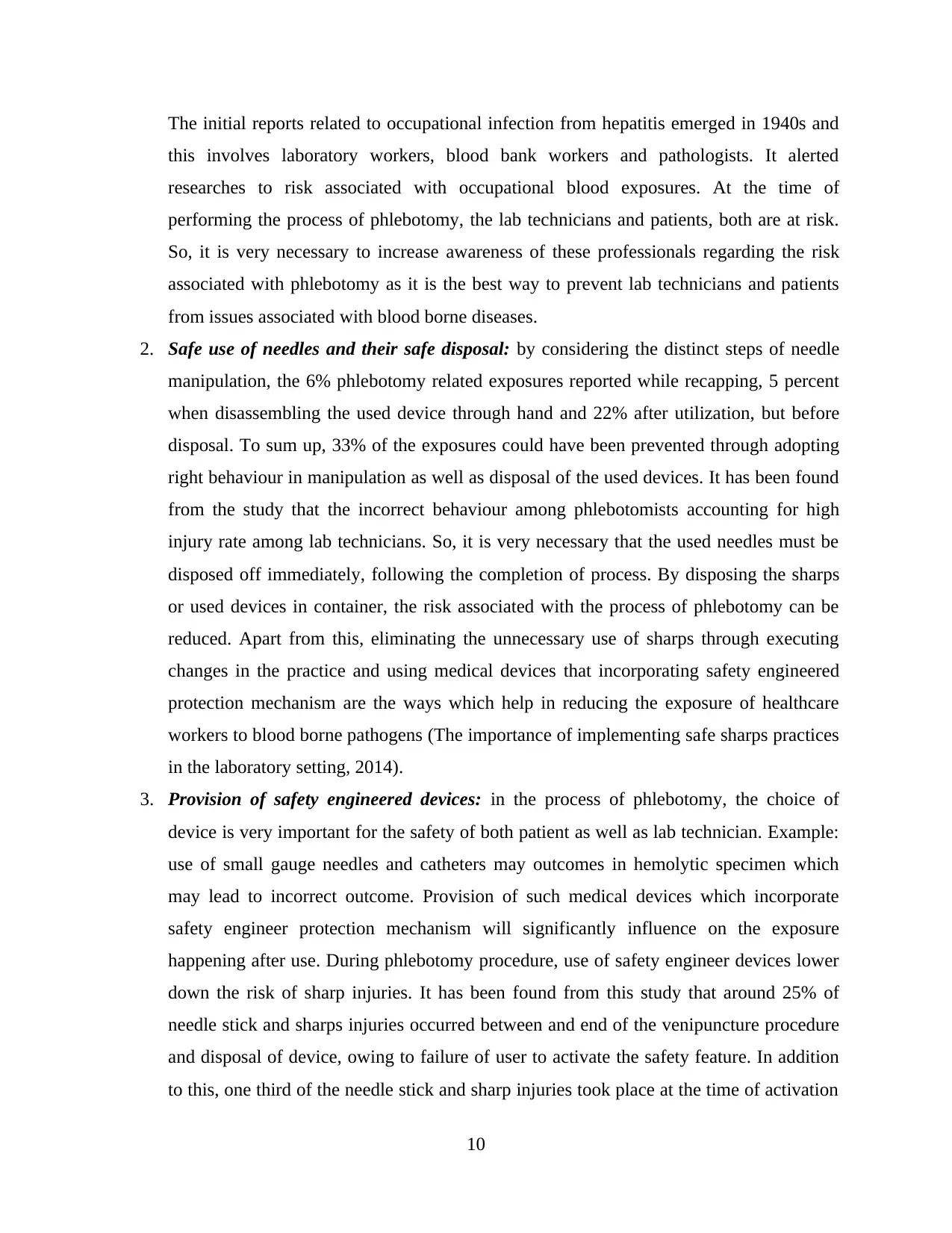
The initial reports related to occupational infection from hepatitis emerged in 1940s and
this involves laboratory workers, blood bank workers and pathologists. It alerted
researches to risk associated with occupational blood exposures. At the time of
performing the process of phlebotomy, the lab technicians and patients, both are at risk.
So, it is very necessary to increase awareness of these professionals regarding the risk
associated with phlebotomy as it is the best way to prevent lab technicians and patients
from issues associated with blood borne diseases.
2. Safe use of needles and their safe disposal: by considering the distinct steps of needle
manipulation, the 6% phlebotomy related exposures reported while recapping, 5 percent
when disassembling the used device through hand and 22% after utilization, but before
disposal. To sum up, 33% of the exposures could have been prevented through adopting
right behaviour in manipulation as well as disposal of the used devices. It has been found
from the study that the incorrect behaviour among phlebotomists accounting for high
injury rate among lab technicians. So, it is very necessary that the used needles must be
disposed off immediately, following the completion of process. By disposing the sharps
or used devices in container, the risk associated with the process of phlebotomy can be
reduced. Apart from this, eliminating the unnecessary use of sharps through executing
changes in the practice and using medical devices that incorporating safety engineered
protection mechanism are the ways which help in reducing the exposure of healthcare
workers to blood borne pathogens (The importance of implementing safe sharps practices
in the laboratory setting, 2014).
3. Provision of safety engineered devices: in the process of phlebotomy, the choice of
device is very important for the safety of both patient as well as lab technician. Example:
use of small gauge needles and catheters may outcomes in hemolytic specimen which
may lead to incorrect outcome. Provision of such medical devices which incorporate
safety engineer protection mechanism will significantly influence on the exposure
happening after use. During phlebotomy procedure, use of safety engineer devices lower
down the risk of sharp injuries. It has been found from this study that around 25% of
needle stick and sharps injuries occurred between and end of the venipuncture procedure
and disposal of device, owing to failure of user to activate the safety feature. In addition
to this, one third of the needle stick and sharp injuries took place at the time of activation
10
this involves laboratory workers, blood bank workers and pathologists. It alerted
researches to risk associated with occupational blood exposures. At the time of
performing the process of phlebotomy, the lab technicians and patients, both are at risk.
So, it is very necessary to increase awareness of these professionals regarding the risk
associated with phlebotomy as it is the best way to prevent lab technicians and patients
from issues associated with blood borne diseases.
2. Safe use of needles and their safe disposal: by considering the distinct steps of needle
manipulation, the 6% phlebotomy related exposures reported while recapping, 5 percent
when disassembling the used device through hand and 22% after utilization, but before
disposal. To sum up, 33% of the exposures could have been prevented through adopting
right behaviour in manipulation as well as disposal of the used devices. It has been found
from the study that the incorrect behaviour among phlebotomists accounting for high
injury rate among lab technicians. So, it is very necessary that the used needles must be
disposed off immediately, following the completion of process. By disposing the sharps
or used devices in container, the risk associated with the process of phlebotomy can be
reduced. Apart from this, eliminating the unnecessary use of sharps through executing
changes in the practice and using medical devices that incorporating safety engineered
protection mechanism are the ways which help in reducing the exposure of healthcare
workers to blood borne pathogens (The importance of implementing safe sharps practices
in the laboratory setting, 2014).
3. Provision of safety engineered devices: in the process of phlebotomy, the choice of
device is very important for the safety of both patient as well as lab technician. Example:
use of small gauge needles and catheters may outcomes in hemolytic specimen which
may lead to incorrect outcome. Provision of such medical devices which incorporate
safety engineer protection mechanism will significantly influence on the exposure
happening after use. During phlebotomy procedure, use of safety engineer devices lower
down the risk of sharp injuries. It has been found from this study that around 25% of
needle stick and sharps injuries occurred between and end of the venipuncture procedure
and disposal of device, owing to failure of user to activate the safety feature. In addition
to this, one third of the needle stick and sharp injuries took place at the time of activation
10
Secure Best Marks with AI Grader
Need help grading? Try our AI Grader for instant feedback on your assignments.
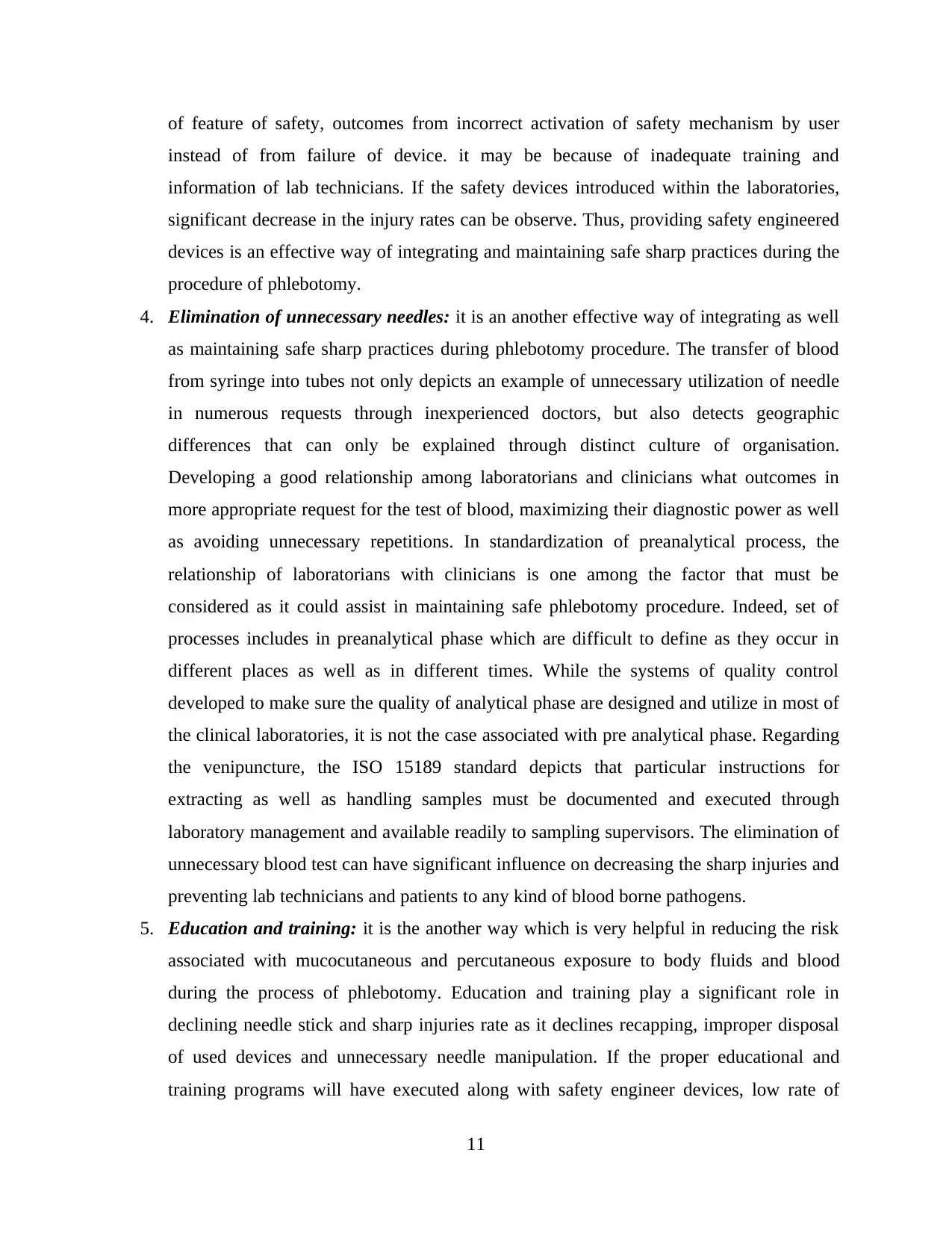
of feature of safety, outcomes from incorrect activation of safety mechanism by user
instead of from failure of device. it may be because of inadequate training and
information of lab technicians. If the safety devices introduced within the laboratories,
significant decrease in the injury rates can be observe. Thus, providing safety engineered
devices is an effective way of integrating and maintaining safe sharp practices during the
procedure of phlebotomy.
4. Elimination of unnecessary needles: it is an another effective way of integrating as well
as maintaining safe sharp practices during phlebotomy procedure. The transfer of blood
from syringe into tubes not only depicts an example of unnecessary utilization of needle
in numerous requests through inexperienced doctors, but also detects geographic
differences that can only be explained through distinct culture of organisation.
Developing a good relationship among laboratorians and clinicians what outcomes in
more appropriate request for the test of blood, maximizing their diagnostic power as well
as avoiding unnecessary repetitions. In standardization of preanalytical process, the
relationship of laboratorians with clinicians is one among the factor that must be
considered as it could assist in maintaining safe phlebotomy procedure. Indeed, set of
processes includes in preanalytical phase which are difficult to define as they occur in
different places as well as in different times. While the systems of quality control
developed to make sure the quality of analytical phase are designed and utilize in most of
the clinical laboratories, it is not the case associated with pre analytical phase. Regarding
the venipuncture, the ISO 15189 standard depicts that particular instructions for
extracting as well as handling samples must be documented and executed through
laboratory management and available readily to sampling supervisors. The elimination of
unnecessary blood test can have significant influence on decreasing the sharp injuries and
preventing lab technicians and patients to any kind of blood borne pathogens.
5. Education and training: it is the another way which is very helpful in reducing the risk
associated with mucocutaneous and percutaneous exposure to body fluids and blood
during the process of phlebotomy. Education and training play a significant role in
declining needle stick and sharp injuries rate as it declines recapping, improper disposal
of used devices and unnecessary needle manipulation. If the proper educational and
training programs will have executed along with safety engineer devices, low rate of
11
instead of from failure of device. it may be because of inadequate training and
information of lab technicians. If the safety devices introduced within the laboratories,
significant decrease in the injury rates can be observe. Thus, providing safety engineered
devices is an effective way of integrating and maintaining safe sharp practices during the
procedure of phlebotomy.
4. Elimination of unnecessary needles: it is an another effective way of integrating as well
as maintaining safe sharp practices during phlebotomy procedure. The transfer of blood
from syringe into tubes not only depicts an example of unnecessary utilization of needle
in numerous requests through inexperienced doctors, but also detects geographic
differences that can only be explained through distinct culture of organisation.
Developing a good relationship among laboratorians and clinicians what outcomes in
more appropriate request for the test of blood, maximizing their diagnostic power as well
as avoiding unnecessary repetitions. In standardization of preanalytical process, the
relationship of laboratorians with clinicians is one among the factor that must be
considered as it could assist in maintaining safe phlebotomy procedure. Indeed, set of
processes includes in preanalytical phase which are difficult to define as they occur in
different places as well as in different times. While the systems of quality control
developed to make sure the quality of analytical phase are designed and utilize in most of
the clinical laboratories, it is not the case associated with pre analytical phase. Regarding
the venipuncture, the ISO 15189 standard depicts that particular instructions for
extracting as well as handling samples must be documented and executed through
laboratory management and available readily to sampling supervisors. The elimination of
unnecessary blood test can have significant influence on decreasing the sharp injuries and
preventing lab technicians and patients to any kind of blood borne pathogens.
5. Education and training: it is the another way which is very helpful in reducing the risk
associated with mucocutaneous and percutaneous exposure to body fluids and blood
during the process of phlebotomy. Education and training play a significant role in
declining needle stick and sharp injuries rate as it declines recapping, improper disposal
of used devices and unnecessary needle manipulation. If the proper educational and
training programs will have executed along with safety engineer devices, low rate of
11
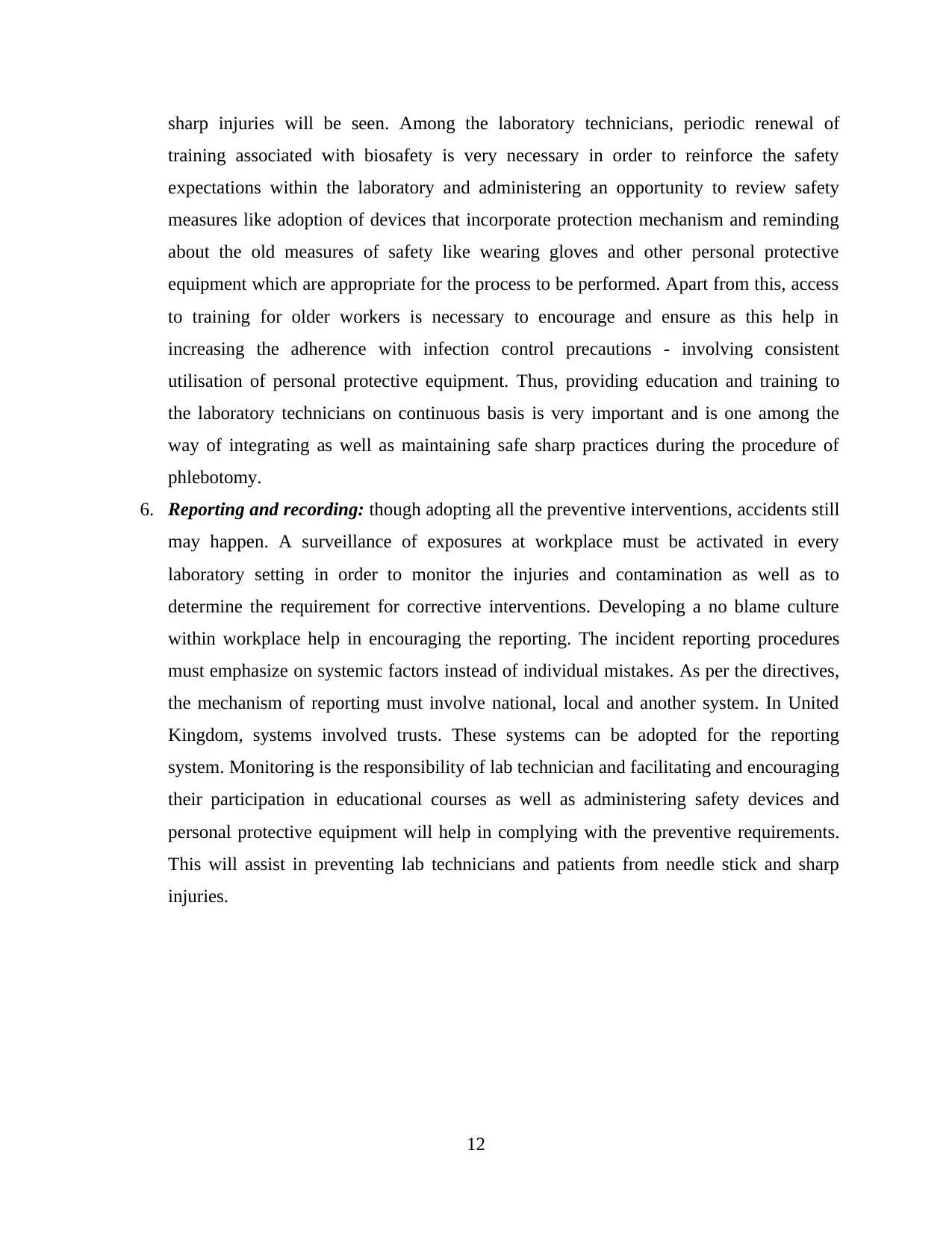
sharp injuries will be seen. Among the laboratory technicians, periodic renewal of
training associated with biosafety is very necessary in order to reinforce the safety
expectations within the laboratory and administering an opportunity to review safety
measures like adoption of devices that incorporate protection mechanism and reminding
about the old measures of safety like wearing gloves and other personal protective
equipment which are appropriate for the process to be performed. Apart from this, access
to training for older workers is necessary to encourage and ensure as this help in
increasing the adherence with infection control precautions - involving consistent
utilisation of personal protective equipment. Thus, providing education and training to
the laboratory technicians on continuous basis is very important and is one among the
way of integrating as well as maintaining safe sharp practices during the procedure of
phlebotomy.
6. Reporting and recording: though adopting all the preventive interventions, accidents still
may happen. A surveillance of exposures at workplace must be activated in every
laboratory setting in order to monitor the injuries and contamination as well as to
determine the requirement for corrective interventions. Developing a no blame culture
within workplace help in encouraging the reporting. The incident reporting procedures
must emphasize on systemic factors instead of individual mistakes. As per the directives,
the mechanism of reporting must involve national, local and another system. In United
Kingdom, systems involved trusts. These systems can be adopted for the reporting
system. Monitoring is the responsibility of lab technician and facilitating and encouraging
their participation in educational courses as well as administering safety devices and
personal protective equipment will help in complying with the preventive requirements.
This will assist in preventing lab technicians and patients from needle stick and sharp
injuries.
12
training associated with biosafety is very necessary in order to reinforce the safety
expectations within the laboratory and administering an opportunity to review safety
measures like adoption of devices that incorporate protection mechanism and reminding
about the old measures of safety like wearing gloves and other personal protective
equipment which are appropriate for the process to be performed. Apart from this, access
to training for older workers is necessary to encourage and ensure as this help in
increasing the adherence with infection control precautions - involving consistent
utilisation of personal protective equipment. Thus, providing education and training to
the laboratory technicians on continuous basis is very important and is one among the
way of integrating as well as maintaining safe sharp practices during the procedure of
phlebotomy.
6. Reporting and recording: though adopting all the preventive interventions, accidents still
may happen. A surveillance of exposures at workplace must be activated in every
laboratory setting in order to monitor the injuries and contamination as well as to
determine the requirement for corrective interventions. Developing a no blame culture
within workplace help in encouraging the reporting. The incident reporting procedures
must emphasize on systemic factors instead of individual mistakes. As per the directives,
the mechanism of reporting must involve national, local and another system. In United
Kingdom, systems involved trusts. These systems can be adopted for the reporting
system. Monitoring is the responsibility of lab technician and facilitating and encouraging
their participation in educational courses as well as administering safety devices and
personal protective equipment will help in complying with the preventive requirements.
This will assist in preventing lab technicians and patients from needle stick and sharp
injuries.
12
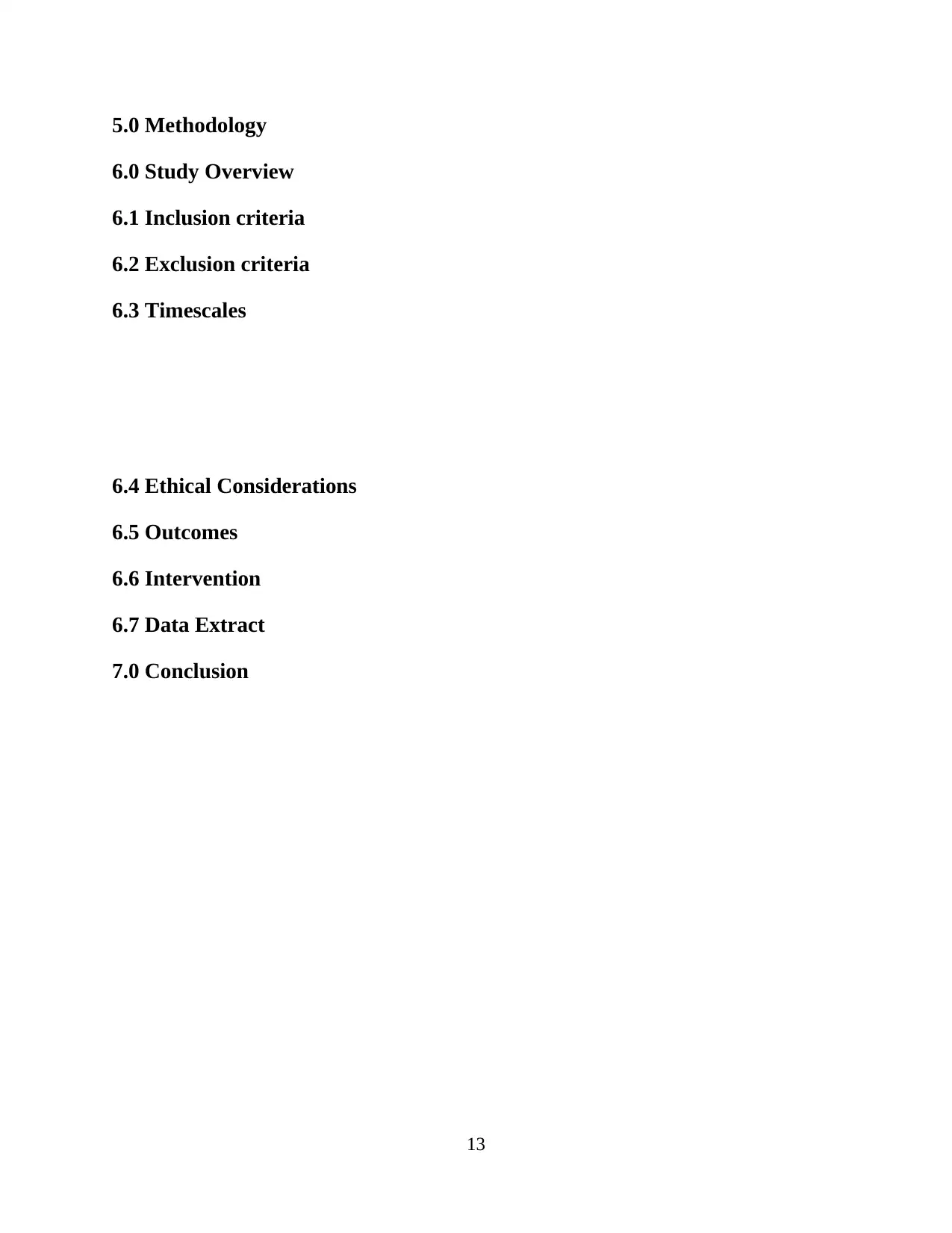
5.0 Methodology
6.0 Study Overview
6.1 Inclusion criteria
6.2 Exclusion criteria
6.3 Timescales
6.4 Ethical Considerations
6.5 Outcomes
6.6 Intervention
6.7 Data Extract
7.0 Conclusion
13
6.0 Study Overview
6.1 Inclusion criteria
6.2 Exclusion criteria
6.3 Timescales
6.4 Ethical Considerations
6.5 Outcomes
6.6 Intervention
6.7 Data Extract
7.0 Conclusion
13
Paraphrase This Document
Need a fresh take? Get an instant paraphrase of this document with our AI Paraphraser
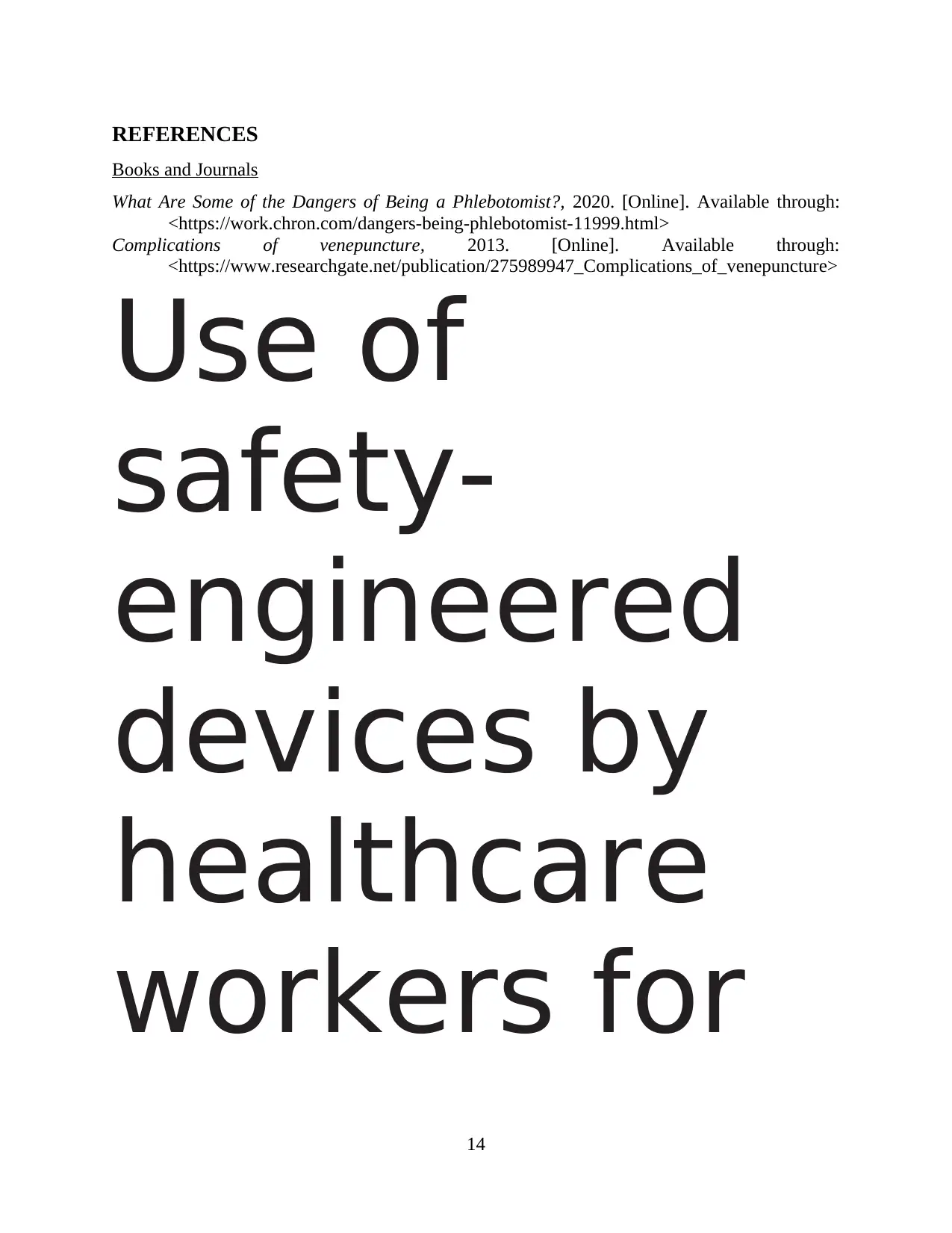
REFERENCES
Books and Journals
What Are Some of the Dangers of Being a Phlebotomist?, 2020. [Online]. Available through:
<https://work.chron.com/dangers-being-phlebotomist-11999.html>
Complications of venepuncture, 2013. [Online]. Available through:
<https://www.researchgate.net/publication/275989947_Complications_of_venepuncture>
Use of
safety-
engineered
devices by
healthcare
workers for
14
Books and Journals
What Are Some of the Dangers of Being a Phlebotomist?, 2020. [Online]. Available through:
<https://work.chron.com/dangers-being-phlebotomist-11999.html>
Complications of venepuncture, 2013. [Online]. Available through:
<https://www.researchgate.net/publication/275989947_Complications_of_venepuncture>
Use of
safety-
engineered
devices by
healthcare
workers for
14
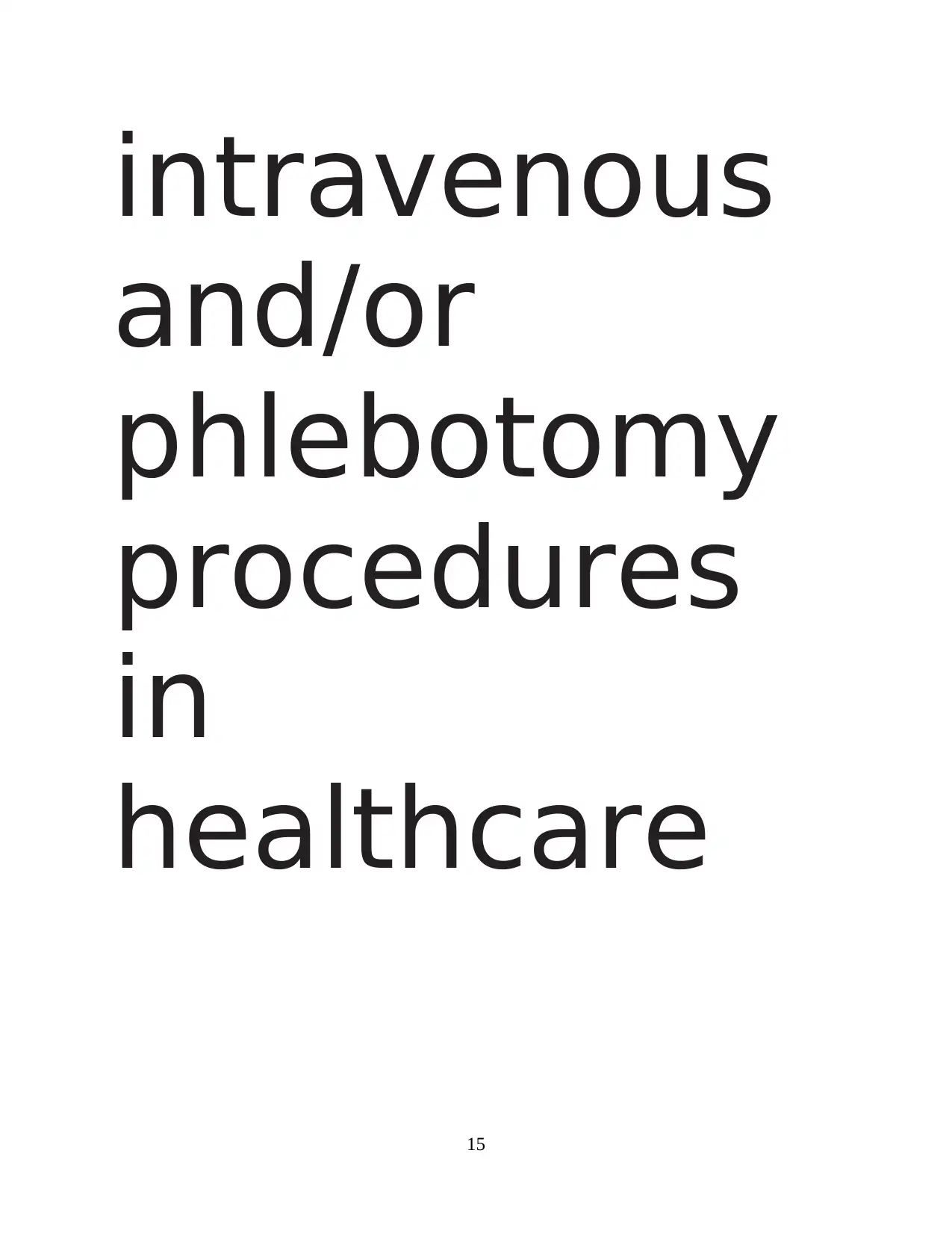
intravenous
and/or
phlebotomy
procedures
in
healthcare
15
and/or
phlebotomy
procedures
in
healthcare
15

settings: a
systematic
review and
meta-
analysisUse of safety-engineered devices by healthcare workers for intravenous and/or phlebotomy
procedures in health care settings: a systematic review and meta-analysis, 2016.
[Online]. Available through:
<https://www.researchgate.net/publication/307579923_Use_of_safety-
engineered_devices_by_healthcare_workers_for_intravenous_andor_phlebotomy_proced
ures_in_healthcare_settings_A_systematic_review_and_meta-analysis>
Issues in phlebotomy, 2010. [Online]. Available through:
<https://www.euro.who.int/__data/assets/pdf_file/0005/268790/WHO-guidelines-on-
drawing-blood-best-practices-in-phlebotomy-Eng.pdf>
The importance of implementing safe sharps practices in the laboratory setting, 2014. [Online].
Available through:
<https://www.biochemia-medica.com/assets/images/upload/xml_tif/De_Carli_G_et_al_-
Safe_sharps_practices_in_European_labs.pdf>
16
systematic
review and
meta-
analysisUse of safety-engineered devices by healthcare workers for intravenous and/or phlebotomy
procedures in health care settings: a systematic review and meta-analysis, 2016.
[Online]. Available through:
<https://www.researchgate.net/publication/307579923_Use_of_safety-
engineered_devices_by_healthcare_workers_for_intravenous_andor_phlebotomy_proced
ures_in_healthcare_settings_A_systematic_review_and_meta-analysis>
Issues in phlebotomy, 2010. [Online]. Available through:
<https://www.euro.who.int/__data/assets/pdf_file/0005/268790/WHO-guidelines-on-
drawing-blood-best-practices-in-phlebotomy-Eng.pdf>
The importance of implementing safe sharps practices in the laboratory setting, 2014. [Online].
Available through:
<https://www.biochemia-medica.com/assets/images/upload/xml_tif/De_Carli_G_et_al_-
Safe_sharps_practices_in_European_labs.pdf>
16
1 out of 16
Your All-in-One AI-Powered Toolkit for Academic Success.
+13062052269
info@desklib.com
Available 24*7 on WhatsApp / Email
![[object Object]](/_next/static/media/star-bottom.7253800d.svg)
Unlock your academic potential
© 2024 | Zucol Services PVT LTD | All rights reserved.

